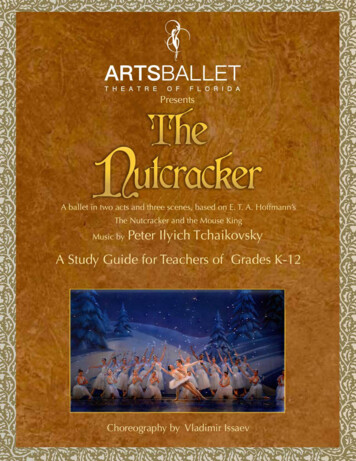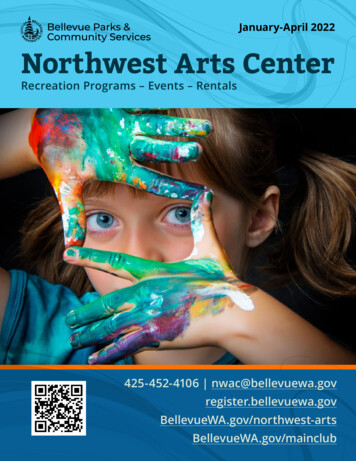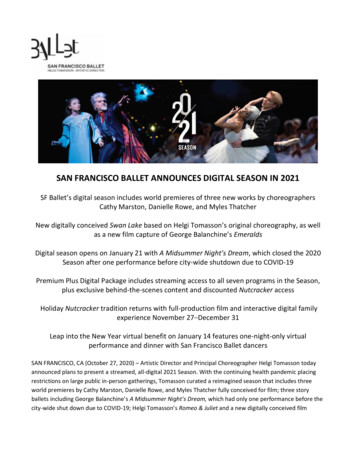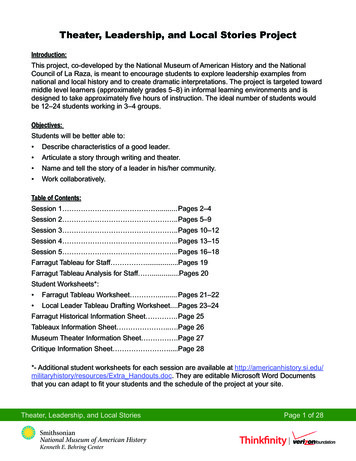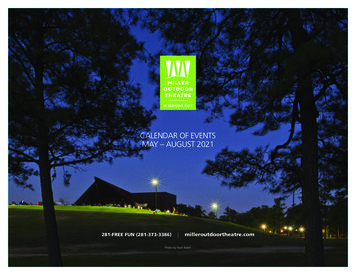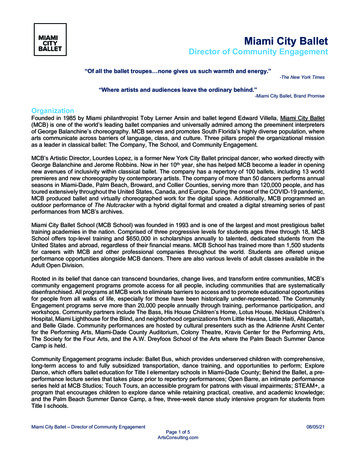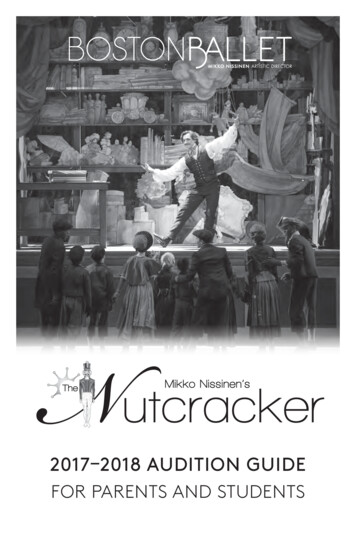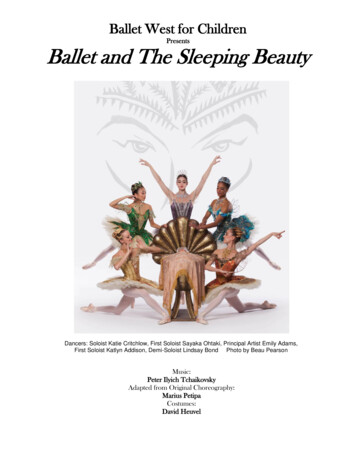
Transcription
Ballet West for ChildrenPresentsBallet and The Sleeping BeautyDancers: Soloist Katie Critchlow, First Soloist Sayaka Ohtaki, Principal Artist Emily Adams,First Soloist Katlyn Addison, Demi-Soloist Lindsay Bond Photo by Beau PearsonMusic:Peter Ilyich TchaikovskyAdapted from Original Choreography:Photo: Quinn FarleyMarius PetipaCostumes:David Heuvel
Dear Dance enthusiast,Ballet West is pleased that you are viewing a Ballet West for Children Presentation as a virtuallearning experience. Enclosed you will find the following information concerning this performance:1. Letter from Artistic Director, Adam Sklute.2. Letter to the parent/guardian of the students who will be viewing.3. Specific Information on this Performance, including information on the ballet, music,choreography, follow-up projects and other pertinent material has also been compiled for theteacher's information.4. We report to the Utah State Board of Education each year on our educational programs, andneed your help. Usually, we gather information from teachers as to how the student reacted andwhat they may have learned from their experience. We’d love to hear from you by filling out ourshort Survey Monkey listed on our virtual learning page. We don’t have a way to track who andhow many people are taking advantage of this opportunity and this will help us to know how we’redoing. You can always email me directly.Thank you very much for your interest in the educational programs of Ballet West. Please call if Imay provide any additional information or assistance to you and your school. I can be reached at801-869-6911 or by email at pchristie@balletwest.org.Sincerely,Peter ChristieDirector of Educational ProgramsEnclosures
Dear Teachers and Administrators,It is with pleasure that I write to tell you of our Ballet West for Children program that isoffered to you free of charge through the combined efforts of Ballet West and the Utah StateBoard of Education. In presenting this award-winning program, Ballet West gives elementarystudents an introduction to the art of ballet.The fifty minute program titled, Ballet and The Sleeping Beauty includes a short historyof ballet specially designed for the young audience, followed by a choreographed sample of adaily ballet class. The professional dancers explain aspects of their art form including basicballet positions, technique, music appreciation, good posture and health, and career dedication.The student participation section illustrates how everyday movements are similar in rhythm,shape and dynamics to ballet steps.Characters from The Sleeping Beauty then demonstrate the techniques of pantomime,pointe work, stage property and pas de deux. The audience travels to the mythical kingdomthrough the eyes of young Princess Aurora and the presentation concludes with a miniatureperformance of The Sleeping Beauty ballet.Enclosed you will find some additional information which I hope will be of interest andassistance to you in preparing your students for our visit.Arts in education is nationally recognized to enrich and broaden the academicachievements of students. Ballet West shares this belief that the highest quality of dance willenlighten, challenge, motivate and edify the minds, the bodies and the spirits of all thechildren in Utah. The artists of Ballet West are excited to share their art with your school.Sincerely,Adam SkluteArtistic DirectorEnclosures
Dear Parent/Guardian,The Utah State Legislature and the Utah State Board of Education have created a remarkableprogram that enriches the lives of schoolchildren in every community in the State. This program iscalled “Professional Outreach Program to Schools” or POPS for short and is funded through thePublic Education Appropriation Committee and the Utah State Board of Education.15 professional organizations currently participate in the POPS program and the RFP program.Together, they bring artists, dancers, musicians, and thespians into the classroom to work directlywith students. The art groups coordinate their visits so that each area of the state and differentschools are visited each year. The groups work through each school district’s coordinator for artsor science. Then the principal is contacted and visits scheduled.There is no cost to the schools receiving these visits because of the appropriation from PublicEducation Appropriation Committee to the Utah State Board of Education. Further, everyorganization participating in POPS brings at least a 100% match of private to state dollars. Thus,schoolchildren all over Utah benefit from the private donations to these 15 world-classorganizations.The groups that receive funding from the POPS program are:Ballet WestNora Eccles Harrison Museum of ArtPlan B TheatreRepertory Dance TheatreRirie Woodbury Dance CompanySpringville Museum of Art-Statewide Art PartnershipSpy HopTanner DanceUtah Museum of Fine ArtsUtah Festival Opera and Musical TheatreUtah Film CenterUtah Museum of Contemporary ArtUtah Shakespeare FestivalUtah OperaUtah SymphonyWe thank you for your past support and ask you to continue supporting the POPS program.Sincerely,Peter ChristieDirector of Educational Programs
o: Quinn FarleyBALLET WEST FOR CHILDREN - PROGRAM DESCRIPTIONThe Ballet West for Children program is designed to give elementary school audiences anintroduction to the art of ballet. A small touring group comprised of Ballet West II company dancersand a narrator performs the presentation entitled, “Ballet and The Sleeping Beauty.”In the 50-minute fully scripted program, the children experience how the basic elements ofdance, music and the visual arts combine into a complete presentation. After an introduction andbrief history of ballet, written especially for this age group, the children see a ballet class set tomusic from Tchaikovsky's Sleeping Beauty. Then the dancers explain aspects of their professionalcareers, such as daily practice, appreciation of music, good posture, basic positions, technique anddedication to their work.The children then participate in two demonstrations. First, we will show how everydaymovements such as running, jumping, skipping and athletic games are similar in rhythm, shapeand dynamics to ballet steps. Volunteers from the student audience are then taught some steps.In costume, the characters of The Sleeping Beauty enter. The Lilac Fairy and Puss-N-Bootsshow how music helps to tell us what kind of dance steps we should be doing. The Lilac Fairyexplains how she dances on her toes and what her pointe shoes are made of, and with the help ofthe narrator, explains how the art of pantomime helps to tell the story. Aurora and the Princedemonstrate how they work together with trust when dancing in a pas de deux.After the narrator introduces the story, the company performs a miniature performance of TheSleeping Beauty for the students. The students enjoy the personal contact with the dancers andthey learn and are rewarded by their experience of ballet.The Sleeping Beauty – The Full StoryPROLOGUE - The ChristeningThe ballet begins on the day of Princess Aurora’schristening. King Florestan and his Queen have invited all the Fairies of the land to be her Godmothers. They dance beautifully for the court presenting their gifts of Purity, Charm, Happiness,Beauty and Strength. Unfortunately, Catalbutte, the King’s assistant, has not remembered toinvite the ill-natured Fairy, Carabosse. She arrives with her attendants in a fury and bestows agift of her own. Presenting to the Queen a spindle as her gift, she foretells that Aurora will growup to be beautiful, gracious and good, but on her sixteenth birthday, will prick her finger and die.The whole court is in despair, but happily the Lilac Fairy has yet to bestow her gift. Though shecannot remove Carabosse’s curse, she can change it. Princess Aurora will not die. Instead,she will sleep for a hundred years to be awakened only by the kiss of a handsome prince.ACT I - Aurora’s 16th BirthdayIt is the celebration of Princess Aurora’s sixteenth birthdayand princes from the four corners of the world have come hoping to win her hand in marriage.She dances the famous Rose Adage with the four Princes with each gives her a rose, Shegrows more confidant with every step. A nurse approaches and gives Aurora a small bouquet offlowers. As she dances throwing the flowers to her friends, a spindle is revealed underneath theflowers. The Queen and King try to warn her but she pricks her finger on the spindle and falls tothe ground apparently lifeless. Everyone is aghast. The nurse reveals herself as the bitterCarabosse and she vanishes. The Lilac Fairy calmly appears and reminds the King and Queenthat she is only asleep. She then casts a spell causing the court to join Aurora in her timelesssleep while a forest of vines grows up around the castle to keep it safe.ACT II - The Vision It is a hundred years later and Prince Florimund heads a hunting party.But he has no heart for the sport and dismisses his party to reflect alone on his longing for anideal love. The Lilac Fairy enters and shows him a vision of Princess Aurora. Enraptured, hedances with her vision among the forest nymphs then he begs the Fairy to lead him to thisbeautiful princess. Together the Lilac Fairy and the Prince travel through changing landscapesand seasons until they reach the hidden castle where he awakens Princess Aurora with a kiss.This breaks the spell and causes the defeated Carabosse to disappear forever.ACT III - The WeddingThe Palace is polished and sparkling for the grand weddingcelebration. Guests come from far away to wish the couple much happiness. Fairy-talecharacters such the White Cat and Puss-n-Boots, Princess Florine and the brilliant Bluebirdattend the wedding celebrations of the Prince and Princess. They pay their respects to thebride and bridegroom, and then the happy couple dances the Grand Pas de Deux expressingtheir love for one another. Finally, the whole assembly joins in a mazurka. In a final apotheosis,the Lilac Fairy appears to bless the marriage.
o: Quinn FarleyBALLET WEST FOR CHILDREN - PROGRAM DESCRIPTIONThe Ballet West for Children program is designed to give elementary school audiences anintroduction to the art of ballet. A small touring group comprised of Ballet West II company dancersand a narrator performs the presentation entitled, “Ballet and The Sleeping Beauty.”In the 50-minute fully scripted program, the children experience how the basic elements ofdance, music and the visual arts combine into a complete presentation. After an introduction andbrief history of ballet, written especially for this age group, the children see a ballet class set tomusic from Tchaikovsky's Sleeping Beauty. Then the dancers explain aspects of their professionalcareers, such as daily practice, appreciation of music, good posture, basic positions, technique anddedication to their work.The children then participate in two demonstrations. First, we will show how everydaymovements such as running, jumping, skipping and athletic games are similar in rhythm, shapeand dynamics to ballet steps. Volunteers from the student audience are then taught some steps.In costume, the characters of The Sleeping Beauty enter. The Lilac Fairy and Puss-N-Bootsshow how music helps to tell us what kind of dance steps we should be doing. The Lilac Fairyexplains how she dances on her toes and what her pointe shoes are made of, and with the help ofthe narrator, explains how the art of pantomime helps to tell the story. Aurora and the Princedemonstrate how they work together with trust when dancing in a pas de deux.After the narrator introduces the story, the company performs a miniature performance of TheSleeping Beauty for the students. The students enjoy the personal contact with the dancers andthey learn and are rewarded by their experience of ballet.The Sleeping Beauty – The Full StoryPROLOGUE - The ChristeningThe ballet begins on the day of Princess Aurora’schristening. King Florestan and his Queen have invited all the Fairies of the land to be her Godmothers. They dance beautifully for the court presenting their gifts of Purity, Charm, Happiness,Beauty and Strength. Unfortunately, Catalbutte, the King’s assistant, has not remembered toinvite the ill-natured Fairy, Carabosse. She arrives with her attendants in a fury and bestows agift of her own. Presenting to the Queen a spindle as her gift, she foretells that Aurora will growup to be beautiful, gracious and good, but on her sixteenth birthday, will prick her finger and die.The whole court is in despair, but happily the Lilac Fairy has yet to bestow her gift. Though shecannot remove Carabosse’s curse, she can change it. Princess Aurora will not die. Instead,she will sleep for a hundred years to be awakened only by the kiss of a handsome prince.ACT I - Aurora’s 16th BirthdayIt is the celebration of Princess Aurora’s sixteenth birthdayand princes from the four corners of the world have come hoping to win her hand in marriage.She dances the famous Rose Adage with the four Princes with each gives her a rose, Shegrows more confidant with every step. A nurse approaches and gives Aurora a small bouquet offlowers. As she dances throwing the flowers to her friends, a spindle is revealed underneath theflowers. The Queen and King try to warn her but she pricks her finger on the spindle and falls tothe ground apparently lifeless. Everyone is aghast. The nurse reveals herself as the bitterCarabosse and she vanishes. The Lilac Fairy calmly appears and reminds the King and Queenthat she is only asleep. She then casts a spell causing the court to join Aurora in her timelesssleep while a forest of vines grows up around the castle to keep it safe.ACT II - The Vision It is a hundred years later and Prince Florimund heads a hunting party.But he has no heart for the sport and dismisses his party to reflect alone on his longing for anideal love. The Lilac Fairy enters and shows him a vision of Princess Aurora. Enraptured, hedances with her vision among the forest nymphs then he begs the Fairy to lead him to thisbeautiful princess. Together the Lilac Fairy and the Prince travel through changing landscapesand seasons until they reach the hidden castle where he awakens Princess Aurora with a kiss.This breaks the spell and causes the defeated Carabosse to disappear forever.ACT III - The WeddingThe Palace is polished and sparkling for the grand weddingcelebration. Guests come from far away to wish the couple much happiness. Fairy-talecharacters such the White Cat and Puss-n-Boots, Princess Florine and the brilliant Bluebirdattend the wedding celebrations of the Prince and Princess. They pay their respects to thebride and bridegroom, and then the happy couple dances the Grand Pas de Deux expressing
their love for one another. Finally, the whole assembly joins in a mazurka. In a final apotheosis,the Lilac Fairy appears to bless the marriage.Ballet West Company HistoryFrom Balanchine to Bournonville and Petipa to Tharp, Ballet West boasts a rich andvaried repertoire, elegant and versatile artists and an American style and legacy that is asdynamic, expansive and unexpected as the Rocky Mountain region it represents. Ballet Westhas toured the world several times over presenting the very best in American classical ballet.Ballet West was established in Salt Lake City in 1963. Willam F. Christensen was thecompany’s first artistic director, co-founding the company together with Utah’s “First Lady of theArts” Glenn Walker Wallace. In 1951, Christensen had established the first ballet department inan American university at The University of Utah and with the tireless assistance of Mrs. EnidCosgriff this program grew into the Utah Civic Ballet, Ballet West’s first incarnation. But this wasnot the first ballet company Willam Christensen’s founded. Along with his brothers Lew andHarold, Christensen made history by establishing the oldest ballet company in the westernUnited States, the San Francisco Ballet. There he went on to create the first full-lengthAmerican productions of Coppélia, Swan Lake, and his evergreen production of The Nutcracker,which remains in Ballet West’s repertoire to this day.With 37 company members, 11 second company members, and a thriving academy thattrains dancers of all ages, many of whom have gone on to professional careers with Ballet Westand companies around the world, Ballet West ranks among the top professional balletcompanies in America. Since its inception, the Company has had five artistic directors – itsfounder Willam Christensen, Bruce Marks, John Hart, Jonas Kåge and currently Adam Sklute,each who have helped to build Ballet West’s unique and expansive profile.A 20th Century ballet pioneer, Christensen developed a distinctly American andtheatrical repertoire for his company based on his early training in Utah and New York City aswell as his years traversing the American Vaudeville circuit. He also built a strong connection tothe works of George Balanchine. In 1975 Christensen invited the great American dancer BruceMarks to join him as Ballet West’s Co-Artistic Director. Marks became Artistic Director in 1978when Christensen retired. Under Marks’ direction, the company presented its first fullproduction of Swan Lake and it earned a reputation for developing emerging choreographers ofthe time. Also during this period Marks made history, along with his wife, the acclaimed DanishBallerina, Toni Lander, by presenting the first American full-length production of Abdallah byrenowned 19th Century Danish choreographer, August Bournonville. John Hart, C.B.E., formerdancer, administrator, and Assistant Director of The Royal Ballet in England succeeded Marksas Artistic Director of Ballet West In 1985. Under his leadership, the company’s repertoire wasexpanded to include more well-loved 19th Century classics such as The Sleeping Beauty. Hartfurther enriched the company’s treasure trove of ballets with the works of many early 20thCentury masters, most notably the great English choreographer, Sir Frederick Ashton. From1985 to 1996, Hart engaged San Francisco-based Val Caniparoli as Ballet West’s residentchoreographer. Internationally known dancer and choreographer Jonas Kåge served as ArtisticDirector from 1997 to 2006. During this time Kåge maintained Ballet West’s repertoire ofclassics while revitalizing its profile with notable late 20th Century choreographers such asChristopher Bruce, Hans van Manen, Glen Tetley and William Forsythe.Since 2007, Artistic Director Adam Sklute, former dancer, Ballet Master and AssociateDirector of The Joffrey Ballet has further energized and expanded Ballet West’s remarkablerepertoire with works by the most renowned choreographers of today such as Ulysses Dove, JiříKylián, Mark Morris, Twyla Tharp, and Stanton Welch. Sklute has also introduced the eleganthistorical masterpieces from the great Ballets Russes of the early 20th Century and continues topreserve Ballet West’s classical legacy. Sklute has further strengthened Ballet West’s heritageby introducing new creations by local, national and international choreographers.For 50 years, Willam Christensen and Ballet West have developed and influencedinnumerable great artists in the ballet world. Some notable figures include Bart Cook, FinisJhung, Jay Jolley, Victoria Morgan, Tomm Ruud, Michael Smuin, Richard Tanner, and KentStowell.With this eclectic and ever expanding outlook, Ballet West is truly an American pioneerin the world of dance.
A Brief History of DanceDance is a way of expressing oneself that has been around throughout the centuries.People have used the language of dance to express a feeling or story. Ancient Greek culture iscredited with the first theatrical dances, but each culture has an identifiable way to express itselfthrough movement. The reasons may be spiritual, social or religious but dance is everywhere. Itsurrounds us. Weddings, social clubs, in the movies, Broadway, all are examples of how danceis ever present in our lives. It lifts our spirits, releases tension, or marks an occasion.As a form of dance, ballet stems from the five positions of the legs and arms that havebeen built upon through the centuries and codified. Classical dance is distinguished by the useof external rotation or turn-out that creates the foundation of classical ballet as well as afreedom of movement in all directions. In the last two centuries the “pointe shoe” and the toedancing that came with the introduction of it have been most identifiable with ballet.European royalty were the first to develop ballets as a form of entertainment. Catherinede Medici, the Italian Queen of France is responsible for bringing the Italian form of “comediadell’arte” to the French court in the 16th century. France’s King Louis XIV was the firstballetomane, and he created the first ballet academy, Academie Royale de Musique in 1669that still exists today as the Paris Opera Ballet. Therefore, most of the ballet terms are inFrench. Women were not involved in the creation of many of the first ballet steps and weren’teven allowed to partake in the art form until 1681. Once allowed, ballerinas began to shortenand lighten their skirts so they could better execute the steps and their movement began to lookmore and more effortless.During the 17th century, ballet began to stand on its own and was no longer anaddendum to an opera. It moved from the palaces to proscenium stages in the 18 th centurythanks in part to the choreographer and ballet master to Marie Antoinette, Jean-GeorgesNoverre. Noverre thought that movement itself should tell a story and under his influence,dancers became trained professionals and the “ballet d’action,” a precursor to the story ballet,was born.The Romantic Era of the late 18th and early 19th centuries coincided with the IndustrialRevolution. There was a sense of displacement in society; therefore, storylines with themes ofgood versus evil, spirit versus flesh flourished. La Sylphide was the first ballet to introduce asupernatural character and influenced changes in theme, style and costuming in ballets. Giselle,choreographed by Jean Coralli and Julles Perrot in 1841, is the culmination of these changes asthe heroine falls in love with the wrong royal, dies of a broken heart and comes back from thedead or spirit world to find redemption. The most significant introduction of the Romantic Erawas that of the pointe shoe. Italian ballerina Marie Taglioni danced “en pointe” in La Sylphide in1822. From that day on, dance was forever changed. The audience began to appreciateballerinas that could execute effortless technique all while portraying a character.The most influential person in America during this time was an Italian ballerina namedFanny Elssler. She toured the country raising the standards of ballet greatly. She had adoringfans that drank champagne from her slippers. America’s first ballerina was Mary Ann Lee fromPhiladelphia. She studied in Philadelphia as well as in Paris under Jean Coralli who taught herGiselle. She was the first to perform the authentic version in America with a man by the name ofGeorge Washington Smith. These two were ahead of their time because it was a few moreyears for ballet to take off on its own in America not involving singing or burlesque dancing.The mid to late 19th century ushered in the Classical Era. There had been a decline inthe popularity of ballet in France, but the Russians maintained the integrity of classical danceduring this time. A man by the name of Marius Petipa arrived in Russia in 1847 and he, alongwith Lev Ivanov, produced many classical ballets in the mid to late 19th century such as TheSleeping Beauty, The Nutcracker, and Swan Lake. The Maryinsky Theater in St. Petersburg, tothis day, is a foundation of Russian ballet. The scores for these ballets were commissioned andwritten with the story line in mind. It was popular in this day to have a composer work for acertain theatre and write music for ballets and operas. These ballets were so strong that theyhave withstood the test of time having changed little over the last century and being referred toas the classics.The early years of the 20th century brought the Modern Era. Sergei Diaghilev and manyof Russia’s finest artists left the Maryinsky Theater during the Russian Revolution in 1917 and
founded Ballet Russes or went on to teach around the world. Finding an international audience,members of Ballet Russes became household names all while influencing the future of the artform. Many protégés such as Ninette de Valois and George Balanchine went on to form majorballet companies, The Royal Ballet in England and The New York City Ballet in the UnitedStates, respectively.The beginning of the contemporary or abstract ballet was born when Diaghilev, a majorproducer of ballets, broke away from the “story” ballet and started requesting thatchoreographers make briefer ballets. He also embraced the change happening in the musicworld where the rigidity of rhythms relaxed and different styles of music influenced differentstyles of dance. These ballets appealed to a wider range of people, not just royalty oraristocracy, and became known as repertoire. A company’s repertoire, or repertory, could begrouped in threes, hence the “triple bill.” Repertory evenings are audience favorites becausemore of the variety is offered.The middle of the 20th century continued to bring some exciting changes in the art form.The world had survived two wars and Russia was no longer open for outsiders to see.Europeans fled the wars and continued west to the Americas. Pioneers in modern dance suchas Isadora Duncan and Martha Graham were taking dance in a new direction, all the whilebreaking down the walls of strict classical technique. American choreographers wereexperimenting with these new styles and America found itself becoming the new center ofdance. Russian stars began to defect and break from the rigidity of the classical style. Dance inthe west was being influenced by jazz, modern dance and different cultures around the world.Rudolf Nureyev, Natalia Makrova, and Mikhail Baryshnikov were the first to dazzle audienceswith their brilliant technique but craved the opportunity to dance other styles of dance.Eventually, with the end of the Cold War, vast opportunities were opened up worldwide. All ofthis kept raising the bar for dancers, and dancers today are required to have a mastery of manystyles in dance. They have to perform the classics with authenticity and purity of line, as well asstretch themselves in neoclassical and modern works.Dance has been around for centuries. Classical dance in all its’ varying forms hasremained a strong cultural presence in many cities throughout the world and the United States,including Salt Lake City. As a language, classical dance will continue to find ways of expressingitself through movement. It will continue to dazzle the eye and enliven the senses. Balletencompasses the purest of styles all the way to the funkiest. Ballet is, after all, an art formmeant to be enjoyed by all.How do we put ballet all together?Like other kinds of performance dance (dance that takes place on stage, in movies, or ontelevision for others to watch), Ballet is a combination of dancing, music, costumes, scenery,and lighting. A new ballet requires the creativity and teamwork of many talented people. Thechoreographer, of course, has the idea for the new ballet and creates all the steps, but alsocounts on a number of other artists to help bring the vision to life. If the ballet is to have originalmusic, the choreographer works closely with a composer, who writes the music or decides whatsounds to use. The costume designer, set designer, and lighting designer also play importantparts in helping the choreographer to make the ballet look just the way it has been envisioned.This section describes the different roles of the many people involved, who work as ateam to help create a new work of art.ChoreographerThe choreographer is the creator of a new ballet. Whether they are tryingto tell a story, interpret a particular piece of music, or express a certain mood or idea, it is thechoreographer who puts together all the ballet’s steps and movements. Just as a painter usescolor, a writer uses words, and a composer uses musical notes, the choreographer uses thesteps and movements of ballet to create their masterpiece.If the ballet is to tell a story, like The Sleeping Beauty or The Nutcracker, the choreographermust first write an outline of the action, divided into scenes and acts just like a play. Becausethere are no words in ballet, everything must be communicated through movement and gesture,and the story should be told as clearly and simply as possible. If a story ballet is created formusic that already exists, the choreographer must also fit the story to the music. If the
choreographer is not working from a story, they might create a ballet to express a certainemotion or feeling. In this case, the movement itself is all-important. With no story outline tofollow, the choreographer uses the movement to create patterns and communicate their ideas tothe audience.Choreographing a new ballet is a very slow process. It can take hours of rehearsal to create oneor two minutes of dance. Creating a whole ballet can take months. Choreographers work indifferent ways when it comes to creating the actual dance steps and movements of a new ballet.Some choreographers work out all the steps ahead of time and just teach them to the dancersonce they are in the studio rehearsals. Others, like George Balanchine, go into the studio with agood idea of what they want to do, but only create the specific steps and movements whileworking with the dancers. For Balanchine, the dancers were an important part of the creativeprocess of choreography. Trying different movements and seeing how they looked on differentdancers’ bodies helped him to decide what ste
Ballet West is pleased that you are viewing a Ballet West for Children Presentation as a virtual learning experience. Enclosed you will find the following information concerning this performance: 1. . up to b
